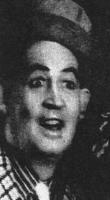Comedian, singer, dancer, writer, director.
Born in Broken Hill, New South Wales, in the early 1890s and raised in Kalgoorlie, Jack Paterson, better known as Dinks Paterson, is believed to have shown an interest in the variety stage from an early age. In this respect, he would have likely been influenced by the slightly older George Sorlie, who also grew up in the Western Australian mining town during the 1890s and early 1900s and learned to perform as an amateur and semi-professional entertainer. After serving in France during the First World War, Paterson returned to Australia and shortly afterwards accepted a contract from Harry Clay to play his Sydney suburban and south-western New South Wales circuit. This engagement led in early 1919 to Paterson and one of Clay's other emerging comedians, George Wallace, teaming up as a duo in the vein of Stiffy and Mo. Although the partnership of Dinks and Oncus was relatively brief, lasting only around four years (1920-1924), it had the distinction of being arguably the most popular comedy duo ever to work for Harry Clay. [For further details regarding Dinks and Oncus, see their entry in AustLit.]
After Wallace and Paterson ended their Dinks and Oncus partnership in late 1923, Paterson formed a new stage partnership with Trixie Ireland, while at the same time briefly touring his own revusical troupe: Dinks and Co. Paterson and Ireland married in 1924. One of their first engagements together was in the Hugh J. Ward/Fullers' 1923/1924 Christmas pantomime Cinderella (Princess Theatre, Melbourne). Shortly after completing this engagement, 'Dinks and Trixie' left to work the United Kingdom's variety circuits. In a letter to Everyone's in late 1928, Paterson records that he and Ireland had scored strongly in London with their act 'Australia's Comedy Novelty': '[We] have worked our act up to a fast flash of 15 minutes, and it is a good one according to the critics. Reeves and Lamport have handled us pretty well all the time and they are a real live firm' (17 October 1928, p.38). During their extended stay in the United Kingdom, Paterson and Ireland appeared in pantomime (invariably as dame and principal boy) and were also involved in a number of revues, including Maurice Cowan's Hello Charleston. In addition to their appearances under Reeves and Lamport, the pair occasionally worked for Stoll Moss. Dinks also worked a baton spinning and eccentric dancing routine in several West End cabarets (Everyone's 24 July 1929, p.4.
Dinks and Trixie remained in England until 4 January 1929, returning to Australia via Africa. Contracted to appear on the Tivoli Celebrity Vaudeville
circuit, they made 'a triumphal homecoming... [but] the lack of
worthwhile opportunities saw them return to the United Kingdom where
they later appeared on early television and toured with headliners like
Gracie Fields' (Frank Van Straten, Tivoli, p.93).
The two comedians came back to Australia in 1948. One of their final
stage performances together was in 1957, when they played the ugly
sisters in an Adelaide production of Cinderella.
Trixie Ireland passed away in 1977, with Paterson following five years later in 1982.
 7985636504395960973.jpg
7985636504395960973.jpg